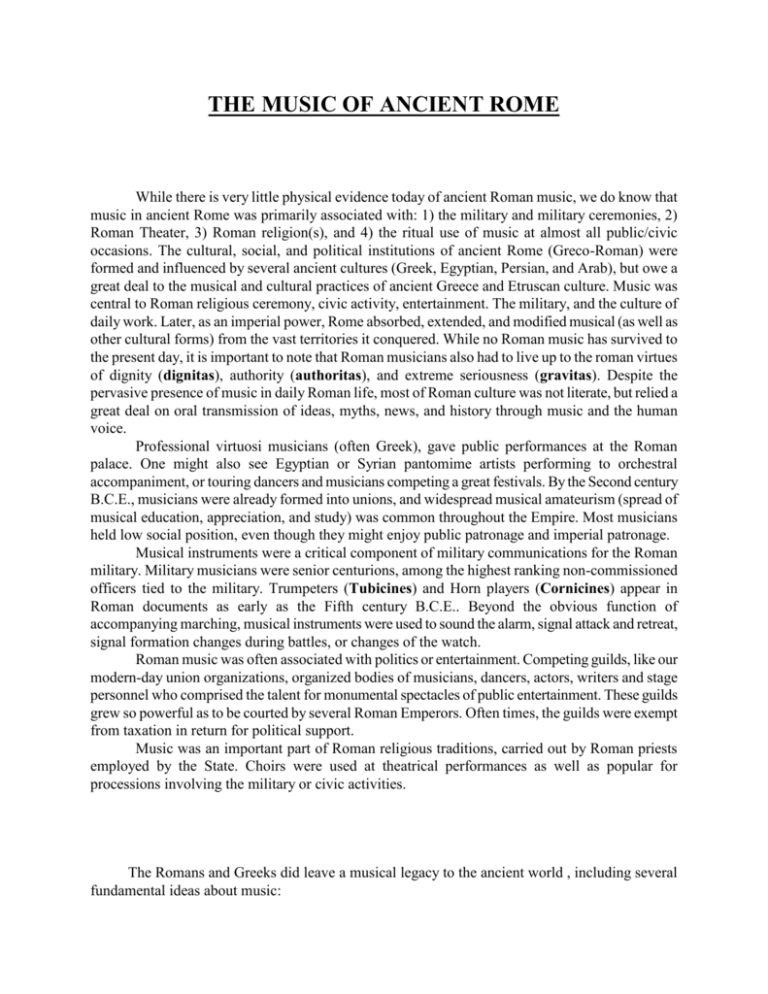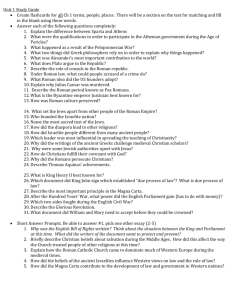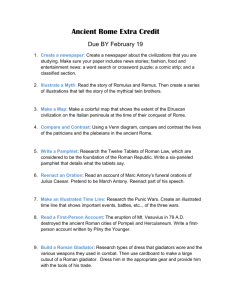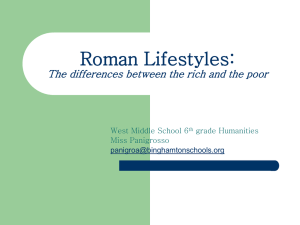Ch. 4 - The Music of Ancient Rome
advertisement

THE MUSIC OF ANCIENT ROME While there is very little physical evidence today of ancient Roman music, we do know that music in ancient Rome was primarily associated with: 1) the military and military ceremonies, 2) Roman Theater, 3) Roman religion(s), and 4) the ritual use of music at almost all public/civic occasions. The cultural, social, and political institutions of ancient Rome (Greco-Roman) were formed and influenced by several ancient cultures (Greek, Egyptian, Persian, and Arab), but owe a great deal to the musical and cultural practices of ancient Greece and Etruscan culture. Music was central to Roman religious ceremony, civic activity, entertainment. The military, and the culture of daily work. Later, as an imperial power, Rome absorbed, extended, and modified musical (as well as other cultural forms) from the vast territories it conquered. While no Roman music has survived to the present day, it is important to note that Roman musicians also had to live up to the roman virtues of dignity (dignitas), authority (authoritas), and extreme seriousness (gravitas). Despite the pervasive presence of music in daily Roman life, most of Roman culture was not literate, but relied a great deal on oral transmission of ideas, myths, news, and history through music and the human voice. Professional virtuosi musicians (often Greek), gave public performances at the Roman palace. One might also see Egyptian or Syrian pantomime artists performing to orchestral accompaniment, or touring dancers and musicians competing a great festivals. By the Second century B.C.E., musicians were already formed into unions, and widespread musical amateurism (spread of musical education, appreciation, and study) was common throughout the Empire. Most musicians held low social position, even though they might enjoy public patronage and imperial patronage. Musical instruments were a critical component of military communications for the Roman military. Military musicians were senior centurions, among the highest ranking non-commissioned officers tied to the military. Trumpeters (Tubicines) and Horn players (Cornicines) appear in Roman documents as early as the Fifth century B.C.E.. Beyond the obvious function of accompanying marching, musical instruments were used to sound the alarm, signal attack and retreat, signal formation changes during battles, or changes of the watch. Roman music was often associated with politics or entertainment. Competing guilds, like our modern-day union organizations, organized bodies of musicians, dancers, actors, writers and stage personnel who comprised the talent for monumental spectacles of public entertainment. These guilds grew so powerful as to be courted by several Roman Emperors. Often times, the guilds were exempt from taxation in return for political support. Music was an important part of Roman religious traditions, carried out by Roman priests employed by the State. Choirs were used at theatrical performances as well as popular for processions involving the military or civic activities. The Romans and Greeks did leave a musical legacy to the ancient world , including several fundamental ideas about music: A scientifically founded acoustical theory of music, complete with an orderly notion of modes or scales, and a complex system of terms to describe musical practices A conception of music consisting of pure, unencumbered melody lines, yet intimately linked to words, especially with regard to rhythm and meter. A tradition of musical performance based on improvisation, without fixed notation, where the performer creates the music anew in each performance, but done within communally accepted conventions of musical style. A philosophy of music which regards Art not as a performance of beautiful sounds (Art for Art=s Sake), but rather as an orderly system interlocked with Nature , and interpreted as a force capable of affecting human thought and conduct.







